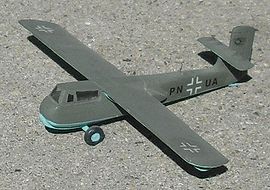Blohm & Voss BV 40
| Blohm & Voss BV 40 | |
|---|---|
 BV40 model |
|
| Type: | Glider |
| Design country: | |
| Manufacturer: | |
| First flight: |
May 1944 |
The Blohm & Voss BV 40 was one of the many attempts by the German Wehrmacht in World War II to combat the Allied bomber streams over Germany .
The glider was small, heavily armored, and equipped with two 30 mm cannons; the landing gear was thrown off after takeoff and landed on a runner. It was set up very simply, as as few materials as possible were to be used. The assembly was also possible for semi-skilled workers in a short time. For use it should be towed (in pairs) by a Messerschmitt Bf 109 ; Above the bomber crowd it was to be released and attack in flight on an incline. Experience had shown that, for example, the large radial engine of the Focke-Wulf Fw 190 was a good target for the gunner of the B-17 and B-24 . Without a motor, the frontal area could be kept so small that a combat glider in a dive would be able to come closer unnoticed until it could open fire itself. They even had the idea of having the BV 40 make a second approach and lowering an explosive device on a rope - but this idea was quickly abandoned. To set up the explosive device, one of the two 30 mm cannons should have been omitted.
The fighter pilots should only receive glider training. At the end of May 1944 the model actually flew; nevertheless the whole project was stopped in the autumn of the same year.
Technical specifications
| Parameter | Data |
|---|---|
| crew | 1 |
| length | 5.70 m |
| span | 7.90 m |
| height | 1.63 m |
| Wing area | 8.70 m² |
| Top speed | 900 km / h in descent, 555 km / h in tow (6000 m altitude) |
| Empty mass | 835 kg |
| Max. Takeoff mass | 950 kg |
| Armament | two 30 mm guns |
See also
Web links
- Data and photos on warbirdsresourcegroup.org (accessed November 17, 2010)